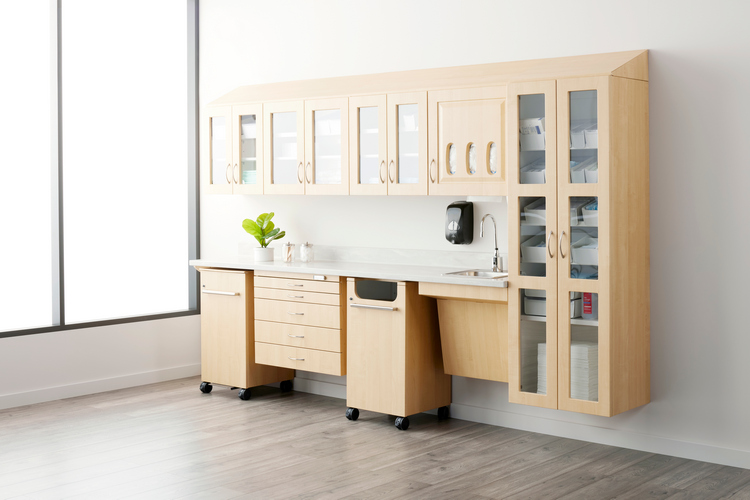Choosing Cabinetry that Brings Value to Your Clinical Environment
How exam room cabinetry is designed and used can have a major impact on efficiency, safety and the healthcare experience.
While a growing number of healthcare organizations now view the cabinetry used in exam rooms as a strategic component of the clinical environment, many still view it as an interchangeable commodity—easily substituted with a low-cost option in the face of budget constraints or cost-cutting efforts.
As a result, when confronted with construction and activation cost overruns on a new build or remodel project, organizations often purchase the lowest cost option when it comes to cabinetry. This usually means consumer-grade millwork composed of wood or fiberboard.
While this decision is understandable, it is important to realize that while lower upfront acquisition costs may seem like an easy option when identifying savings, there can be additional associated costs when utilizing cabinetry not specifically designed for the medical environment.
The cabinetry used in exam rooms is an integral part of the point of care and the delivery of quality care. The way it is designed and utilized within the clinical environment can often impact workflow efficiency, safety initiatives and the healthcare experience for both patients and caregivers.
The Value of Medical-Grade Point of Care Cabinetry
When you are making a purchasing decision pertaining to cabinetry, four primary design features to consider are (1) flexibility and adaptability, (2) ergonomic reach range, (3) efficient supply organization options, and (4) safety in infection prevention and durability. When these design features are present, it helps ensure you are getting a better grade product and it can eliminate additional costs when you install it in your clinical space.
The Midmark white paper, “Ergonomics at the Point of Care: How Equipment Designed with Ergonomic Principles Enhances the Caregiver Experience,” discusses the importance of cabinetry design in terms of ergonomic principles, while a second Midmark white paper, “Point of Care Inventory Control: A Place for Everything and Everything in its Place,” explores cabinetry options that increase storage space at the point of care. In the most recent Midmark white paper, “Flexibility and Durability: Choosing Cabinetry that Brings Value to Your Clinical Environment,” we look at the remaining two factors: flexibility and adaptability, and safety in infection prevention and durability.
When it comes to flexibility and adaptability, choosing cabinetry that features a modular design can allow you to adapt it quickly and easily as the needs of the space change. Millwork cabinetry is not modular, which means it typically cannot be easily moved, changed or reconfigured. If you move to a new facility or undertake a renovation, you may be forced to scrap and fully replace the existing cabinetry.
In terms of durability and safety in infection prevention, the cabinetry you install should be designed to withstand the rigors of daily use in a non-acute environment. Along with moisture damage and deterioration issues, consumer-grade cabinetry can break down faster amid rigorous cleaning protocols using medical-grade cleaners. Cleaning can cause splitting, cracking and swelling around the joint areas. These damaged areas can become adhesive to contaminates, exposing patients and clinical staff to increased levels of infectious bacteria or viruses.
When purchasing cabinetry for a non-acute environment, it may be tempting to go with the lowest cost option. However, it might not make sense when considering the design and construction process, clinical demands and long-term life cycle of the product.
To learn more about Midmark cabinetry or for help with your next project, visit the Midmark Synthesis® Cabinetry page.
Posted February 29, 2024
More Articles:
- CxA Workshop & Exam
Apr 29, 2024 – Apr 30, 2024 - EMP Seminar & Exam at CxEnergy 2024
Apr 29, 2024 – Apr 30, 2024 - CxEnergy
Apr 29, 2024 – May 2, 2024 - PHCC West 2024
Apr 29, 2024 – May 2, 2024 - Lean in Design Forum 2024
May 1, 2024 – May 2, 2024 - IFMA’s Facility Fusion Conference & Expo
May 5, 2024 – May 7, 2024 - ASHE Academy 2024
May 6, 2024 – May 10, 2024











